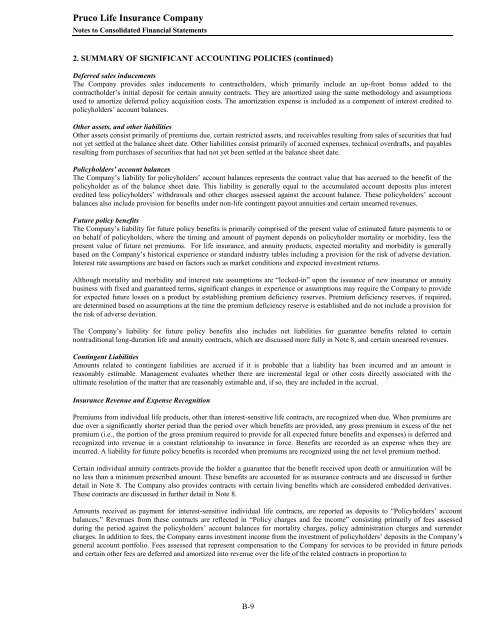The Prudential Series Fund
The Prudential Series Fund
The Prudential Series Fund
Create successful ePaper yourself
Turn your PDF publications into a flip-book with our unique Google optimized e-Paper software.
Pruco Life Insurance Company<br />
Notes to Consolidated Financial Statements<br />
2. SUMMARY OF SIGNIFICANT ACCOUNTING POLICIES (continued)<br />
Deferred sales inducements<br />
<strong>The</strong> Company provides sales inducements to contractholders, which primarily include an up-front bonus added to the<br />
contractholder’s initial deposit for certain annuity contracts. <strong>The</strong>y are amortized using the same methodology and assumptions<br />
used to amortize deferred policy acquisition costs. <strong>The</strong> amortization expense is included as a component of interest credited to<br />
policyholders’ account balances.<br />
Other assets, and other liabilities<br />
Other assets consist primarily of premiums due, certain restricted assets, and receivables resulting from sales of securities that had<br />
not yet settled at the balance sheet date. Other liabilities consist primarily of accrued expenses, technical overdrafts, and payables<br />
resulting from purchases of securities that had not yet been settled at the balance sheet date.<br />
Policyholders’ account balances<br />
<strong>The</strong> Company’s liability for policyholders’ account balances represents the contract value that has accrued to the benefit of the<br />
policyholder as of the balance sheet date. This liability is generally equal to the accumulated account deposits plus interest<br />
credited less policyholders’ withdrawals and other charges assessed against the account balance. <strong>The</strong>se policyholders’ account<br />
balances also include provision for benefits under non-life contingent payout annuities and certain unearned revenues.<br />
Future policy benefits<br />
<strong>The</strong> Company’s liability for future policy benefits is primarily comprised of the present value of estimated future payments to or<br />
on behalf of policyholders, where the timing and amount of payment depends on policyholder mortality or morbidity, less the<br />
present value of future net premiums. For life insurance, and annuity products, expected mortality and morbidity is generally<br />
based on the Company’s historical experience or standard industry tables including a provision for the risk of adverse deviation.<br />
Interest rate assumptions are based on factors such as market conditions and expected investment returns.<br />
Although mortality and morbidity and interest rate assumptions are ―locked-in‖ upon the issuance of new insurance or annuity<br />
business with fixed and guaranteed terms, significant changes in experience or assumptions may require the Company to provide<br />
for expected future losses on a product by establishing premium deficiency reserves. Premium deficiency reserves, if required,<br />
are determined based on assumptions at the time the premium deficiency reserve is established and do not include a provision for<br />
the risk of adverse deviation.<br />
<strong>The</strong> Company’s liability for future policy benefits also includes net liabilities for guarantee benefits related to certain<br />
nontraditional long-duration life and annuity contracts, which are discussed more fully in Note 8, and certain unearned revenues.<br />
Contingent Liabilities<br />
Amounts related to contingent liabilities are accrued if it is probable that a liability has been incurred and an amount is<br />
reasonably estimable. Management evaluates whether there are incremental legal or other costs directly associated with the<br />
ultimate resolution of the matter that are reasonably estimable and, if so, they are included in the accrual.<br />
Insurance Revenue and Expense Recognition<br />
Premiums from individual life products, other than interest-sensitive life contracts, are recognized when due. When premiums are<br />
due over a significantly shorter period than the period over which benefits are provided, any gross premium in excess of the net<br />
premium (i.e., the portion of the gross premium required to provide for all expected future benefits and expenses) is deferred and<br />
recognized into revenue in a constant relationship to insurance in force. Benefits are recorded as an expense when they are<br />
incurred. A liability for future policy benefits is recorded when premiums are recognized using the net level premium method.<br />
Certain individual annuity contracts provide the holder a guarantee that the benefit received upon death or annuitization will be<br />
no less than a minimum prescribed amount. <strong>The</strong>se benefits are accounted for as insurance contracts and are discussed in further<br />
detail in Note 8. <strong>The</strong> Company also provides contracts with certain living benefits which are considered embedded derivatives.<br />
<strong>The</strong>se contracts are discussed in further detail in Note 8.<br />
Amounts received as payment for interest-sensitive individual life contracts, are reported as deposits to ―Policyholders’ account<br />
balances.‖ Revenues from these contracts are reflected in ―Policy charges and fee income‖ consisting primarily of fees assessed<br />
during the period against the policyholders’ account balances for mortality charges, policy administration charges and surrender<br />
charges. In addition to fees, the Company earns investment income from the investment of policyholders’ deposits in the Company’s<br />
general account portfolio. Fees assessed that represent compensation to the Company for services to be provided in future periods<br />
and certain other fees are deferred and amortized into revenue over the life of the related contracts in proportion to<br />
B-9
















